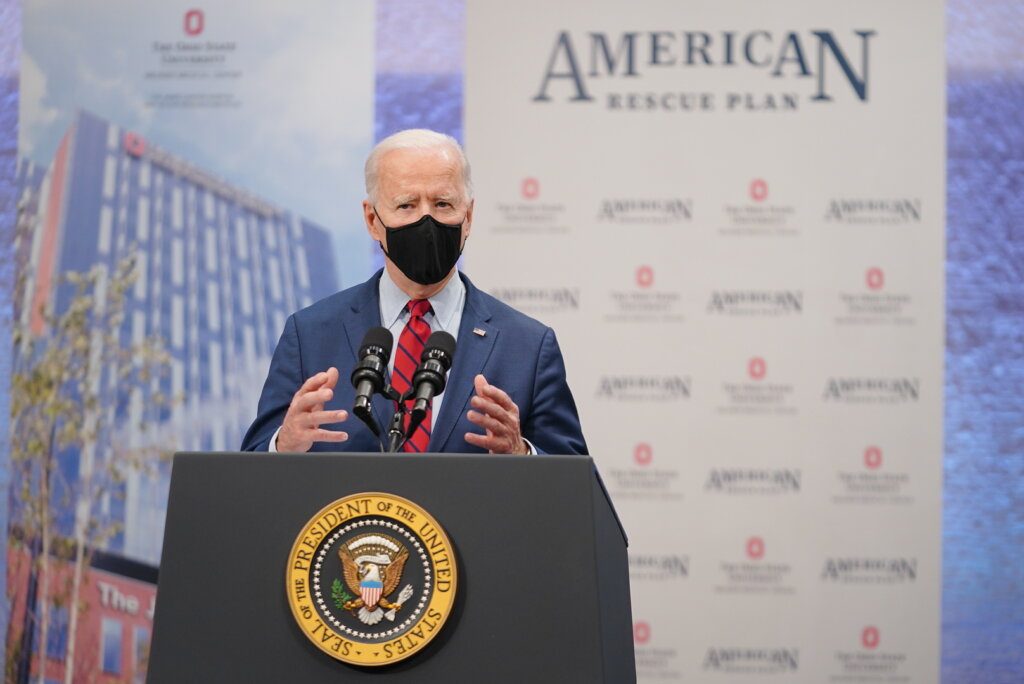$200 Million From ARPA Sent to Local Governments in State
Funding program helps support public health, recover from pandemic, recoup lost revenue.

President Joe Biden March 23, 2021, at the Arthur James Cancer Hospital and the Richard Solove Research Institute in Columbus, Ohio. Official White House Photo by Adam Schultz.
Local governments big and small across Wisconsin received a total of $200 million through the American Rescue Plan Act (ARPA) this week. The program is meant to help local governments recover from the COVID-19 pandemic and was disbursed by the Wisconsin Department of Administration.
The amount each municipality received was determined through a formula based on its population. The state’s larger cities already received their funds directly from the federal government. The payments, according to data from the office of Gov. Tony Evers, reach as high as $2 million for larger municipalities such as Brookfield in Waukesha County and as low as $2,200 for towns and villages as small as Cedar Rapids in Rusk County.
The $1.9 trillion ARPA was signed into law by President Joe Biden in March and Gov. Evers said the funds will help people across the state recover from the damage caused by COVID.
“I am very pleased to report that so many of our local communities and governments are taking advantage of these federal funds to make improvements in their communities that they otherwise would not have had the funds to do,” Evers said in a statement. “From addressing the public health impacts of the pandemic to investing in needed critical infrastructure, to helping ensure families and businesses financially recover, these funds will allow local governments to invest in their community’s unique needs and will make a major difference for Wisconsinites across our state.”
Each municipality received one payment this year and will receive a second payment of the same amount next year.
In Cedar Rapids, with a population of 42, Town Chair Jelena Englund says officials are still waiting for guidance on how they can use the $2,198.04 they’ve received through the program.
Englund says that with a town budget of less than $200,000 that amount of money can still make a difference.
“It’ll help improve some of the stuff we have around,” she says. “Our town is small, we only have like 33 voters and we’ve got like 18 miles of road. We were thinking of putting wifi and all that stuff in our town hall.”
“Part of what we’ll use here in Stockholm is purchasing a new election machine,” says Cindy Fayerweather, clerk and treasurer of the town of 64 people. “Beyond that, they’ve not really decided. Considering our levy is $22,000, an additional $3,000 to $6,000, that’s a very nice amount.”
While election equipment is a critical piece of infrastructure, officials in the Town of Kingston in Juneau County were hoping to purchase something just as crucial, according to town clerk Ellen Carter. Kingston, with a population of 89, received $4,657.75.
“At the present time we haven’t figured out what to do with the money,” Carter says. “We’re hoping to be able to put a flush toilet in the town hall. We have no washroom facilities. We were hoping to do that. In the meantime, we’re stuck until we hear what we can do with it. [We] can’t use it on the roads so the only other option would be to give it to the ambulance service or the fire department for equipment.”
In larger municipalities, capital expenses are too large to use the funds for big purchases, so the money is being used to plug holes that were caused by the pandemic.
The City of Brookfield, one of the largest municipalities in the group that received new funds this week, got $2,047,055.26. Finance director Robert Scott says the payment, for now, will go toward replacing revenue sources that still haven’t recovered, like the city’s hotel tax, that help pay for city services.
“In my pocket it would be a lot of money but we only got $4.1 million, so in the context of a city budget it’s not that much,” he continues, referring to the total amount the city will receive over the next two years. “That was the direction they gave, we’ll be utilizing about $1.1 million to support costs for the 2022 budget and go from there in terms of future years.”
Local governments have until 2024 to determine how the funds will be spent and until 2026 to spend them.
$200 million in ARPA money sent to local governments across Wisconsin was originally published by the Wisconsin Examiner.


















